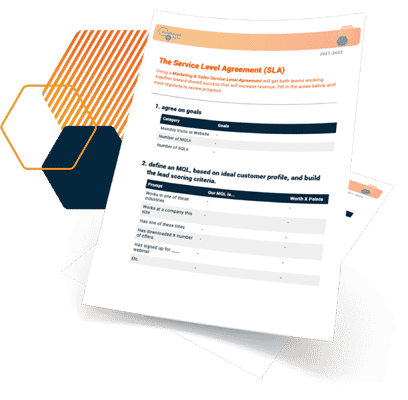
Let’s be honest—marketing and sales can sometimes feel like siblings who love each other but can’t stop arguing. If you’ve ever felt friction between the two, you’re not alone. Even the strongest teams can find themselves misaligned—marketing believes they’re driving qualified leads, while sales insists the leads aren’t ready or relevant. The result? Missed revenue targets, stalled growth, and plenty of finger-pointing.
A Marketing and Sales Service Level Agreement (SLA) is your solution. But not just any SLA—a living, actionable, mutually beneficial agreement that drives accountability and results.
Here’s how to build one that actually works.
What Is a Marketing & Sales Service Level Agreement?
A Marketing and Sales SLA is a formal agreement between the two teams that outlines:
- What qualifies as a “good” lead
- How many qualified leads marketing will deliver
- How quickly sales must follow up
- How both sides measure performance
- What happens when targets aren’t met
Think of it as a shared promise—and a roadmap—for hitting revenue goals together.
Why an SLA Matters (More Than You Think)
A well-crafted service level agreement:
- Reduces Misalignment: It gets everyone on the same page about lead quality, expectations, and responsibilities.
- Boosts Revenue Predictability: With clear numbers, follow-up timelines, and processes, forecasting becomes more accurate.
- Increases Lead Conversion Rates: The faster sales follow up and the more qualified the lead, the higher the conversion potential.
- Encourages Accountability on Both Sides: No more “marketing isn’t sending good leads” or “sales never follows up.” The data settles it.
How to Create a Marketing & Sales SLA That Works
1. Start With Shared Revenue Goals
Everything should tie back to revenue—not just MQLs or call volume. When both teams understand what they’re working toward, collaboration becomes natural.
Define:
- Quarterly or annual revenue targets
- Average deal size
- Marketing’s contribution to pipeline
- Sales’ conversion benchmarks
2. Define Your Lead Lifecycle Stages
Clear, consistent definitions eliminate confusion. Work together to assign criteria for each stage (e.g., behavior, demographic fit, intent signals).
Common stages include:
- Lead
- Marketing Qualified Lead (MQL)
- Sales Qualified Lead (SQL)
- Opportunity
- Customer
3. Agree on What Makes a “Qualified” Lead
This is where misalignment usually happens.
Build a shared definition using:
- Firmographic data (industry, size, revenue)
- Demographic info (title, department)
- Behavioral triggers (downloads, demo requests)
- Intent data (visited pricing page, comparison research)
Tip: Create a scorecard—objective criteria beat gut feelings every time.
4. Set Lead Volume & Quality Targets for Marketing
These targets must align with revenue projections—not arbitrary MQL goals.
Marketing should commit to:
- Number of qualified leads per month or quarter
- Lead quality thresholds (based on your scorecard)
- Required data points for each lead
5. Set Follow-Up SLAs for Sales
Sales should commit to:
- Timely Follow-up (e.g., within 1 hour of MQL → SQL handoff)
- Number of attempts per lead
- Required documentation in the CRM
- Minimum conversion rate expectations
Response time is huge—research shows that contacting a lead within 60 minutes can increase conversions by up to 7x.
6. Map the Handoff Process
Think of this as the choreography between teams. This minimizes dropped leads and duplicate efforts.
Document:
- How and where leads are passed from marketing to sales (think: CRM automation)
- Required qualification fields
- Notification process
- What happens if a lead doesn’t meet the criteria
- When leads get recycled back to marketing
7. Determine How Lead Rejection Works
Lead rejection is normal—but it needs structure. This step prevents the “sales rejects everything” problem.
Outline:
- Valid reasons for rejection
- What data sales must provide
- How marketing reviews and improves based on feedback
8. Establish Reporting & Measurement Cadence
Weekly or bi-weekly reviews work best. Shared dashboards promote transparency—and good data fuels better decisions.
Track:
- MQL → SQL conversion rate
- SQL → Opportunity → Closed Won
- Average follow-up time
- Lead quality scoring data
- Pipeline contribution by source
9. Include Accountability Measures
This is where your SLA becomes real. Accountability should feel fair, not punitive.
Examples:
- If marketing misses lead targets → adjust campaigns or budget
- If sales misses follow-up SLAs → reallocation of leads or coaching
- If conversion rates drop → jointly revisit qualification criteria
10. Review & Optimize Quarterly
Your SLA is a living document—not a one-and-done task.
Every quarter:
- Revisit definitions and targets
- Evaluate what’s working (and what isn’t)
- Update processes based on real-world performance and market conditions
Get Started with your Service Level Agreement
A strong Marketing and Sales SLA is the backbone of a high-performing revenue engine. When done right, it fosters collaboration, reduces friction, and creates predictable, scalable growth.
Remember: the goal isn’t to make one team “better”—it’s to make the whole customer journey better. If your teams are struggling to stay aligned, implementing a thoughtful SLA can change the game.
If you’d rather not build your SLA alone, Hivehouse Digital is here to help. At Hivehouse Digital, we specialize in aligning marketing and sales through smart strategy, performance-driven websites, and streamlined CRM workflows. We partner closely with you to define lead stages, improve qualification, build dashboards, and create processes that actually drive growth. Whether you’re starting fresh or refining what you have, we’ll help you create an SLA that truly works.
Still Looking For Answers? We Can Help!
Get the latest news
Blog Topics
- AI
- Analytics
- Branding & Identity
- Budget
- Construction
- Content Marketing
- Conversion Rate Optimization
- Email Marketing
- HubSpot
- Inbound Marketing
- Lead Generation
- Marketing Strategy
- News/Events
- Paid Search & PPC
- Recruiting
- Sales & Marketing
- Sales Enablement
- Search Engine Marketing
- Search Engine Optimization
- Social Media
- Thought Leadership
- Uncategorized
- Usability
- Video Marketing
- Web Hosting
- Website Design

